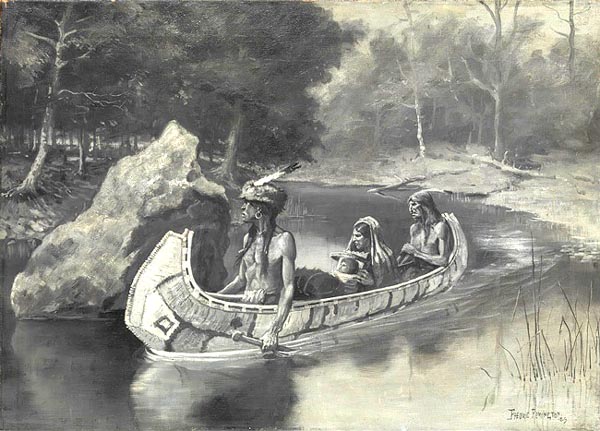 |
| "Hiawatha's Friends" by Remington (Wikipedia) |
Note: Meet one of the most famous culture heroes from Native American mythology--and American poetry!--and visit the shores of Gitche Gumee in this lesson.
Get Ready: Why do you think ancient peoples attributed progress--the creation of writing, or the growing of crops, for example--to a single individual, instead of seeing such things as processes taking place over many generations?
Let's look at the story contained in The Song of Hiawatha, by the most popular poet of his day, the American Henry Wadsworth Longfellow (1807-1882). One friend wrote of him, "no other poet was so fully recognized in his lifetime."
The epic poem has 22 chapters and well over 5,000 lines. One line of the poem is very familiar, but most people know no more than that. "By the shores of Gitche Gumee," it says, and continues:
By the shining Big-Sea-Water,
Stood the wigwam of Nokomis
Daughter of the Moon, Nokomis.
This Nokomis--who actually fell from the moon, according to the story--is Hiawatha's grandmother. This little tidbit hints at the idea of the poem: Longfellow weaves myths of Native American culture into a story about a culture hero known (outside of the poem) as Manabozho. Longfellow also introduced plenty of his own ideas, for dramatic effect.
"Gitche Gumee," by the way, is Lake Superior, the northernmost of the five "Great Lakes" along the U.S./Canadian border. (In fact, that border runs right through it.)
Predictions of Hiawatha's birth say he is to be a mighty leader who will bring peace to his people. But we also hear numerous myths about the time before his birth, such as the slaying of Mishe-Mokwa, the Great Bear of the mountains, by the warrior Mudjekeewis. As a result, Mudjekeewis becomes the Father of the Four Winds. He himself becomes the West Wind; his three sons are the others.
Nokomis, meanwhile, gives birth to the beautiful maiden Wenonah, who, after being seduced by Mudjekeewis, gives birth to Hiawatha. After a number of childhood adventures, the young warrior meets and falls in love with Minnehaha, a girl from another tribe, the Dakota. (Sadly, Minnehaha dies of starvation in a harsh winter.) As a proper culture hero, Hiawatha: invents reading and writing; discovers corn; brings numerous other gifts to his people; and slays monsters that threaten their well-being.
Near the end of the poem Hiawatha joyously greets the arrival of the "paleface." He and his chiefs become Christians, and he then paddles away in his canoe, leaving instructions that his people are to "Listen to the truth [the missionaries] tell you."
--------
Read more: https://en.wikipedia.org/wiki/The_Song_of_Hiawatha
Practice: Match the term to its definition below:
- canoe
- culture hero
- epic poem
- myths
- paleface
- seduced
- starvation
- tidbit
- weaves
- wigwam
- persuaded to have sex
- one that is long and tells of extraordinary people dealing with gods or natural forces
- a Native American boat, pointed at both ends
- stories of the gods and humans
- puts together; combines
- a mythical human who brought his people the foundations of their civilization
- severe hunger
- a Native American tent; also called a tepee
- a small piece of something
- a supposed Native American term for white people
Answers are in the first comment below.
Submitted to the Shenzhen Daily for August 23, 2021


Answers to the Practice: 1. c; 2. f; 3. b; 4. d; 5. j; 6. a; 7. g; 8. i; 9. e; 10. h
ReplyDelete